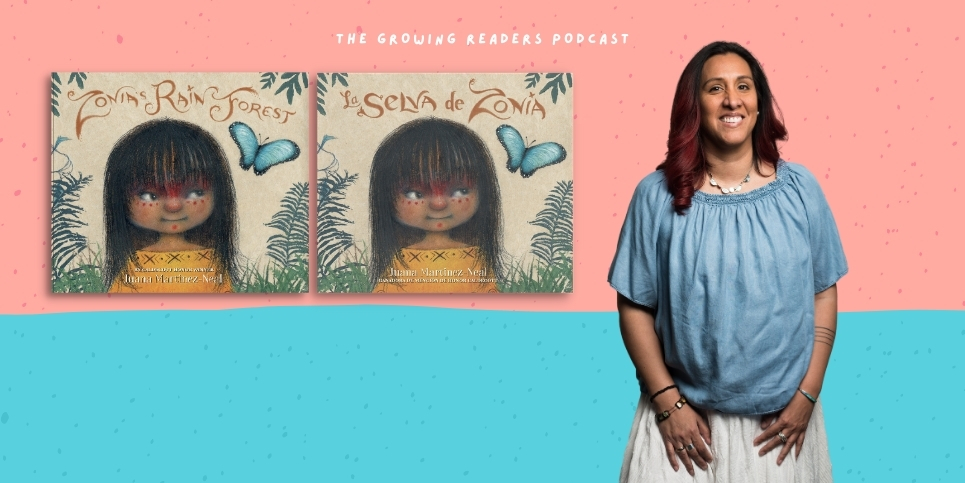An interview with Juana Martinez-Neal
The Children’s Book Review
In this episode of the Growing Readers Podcast, I talk with the absolutely incredible, award-winning author-illustrator Juana Martinez-Neal. We discuss the heartfelt, visually stunning picture book Zonia’s Rain Forest, which illuminates a young girl’s day of play and adventure in the lush rain forest of Peru.
Juana Martinez-Neal is one of my all-time favorite illustrators. We talk about the idea of home and how different people experience home, in particular, how Zonia, an Asháninka girl, experiences her home and how we are all connected. We also discuss how the idea for this book crept up on her and the different techniques she used to create the gorgeous mixed-media artwork that pulls the reader into the pages. This book, also available in Spanish: La selva de Zonia, is both a conversation starter and a feast for the eyes!
Listen to the Interview
About the Book
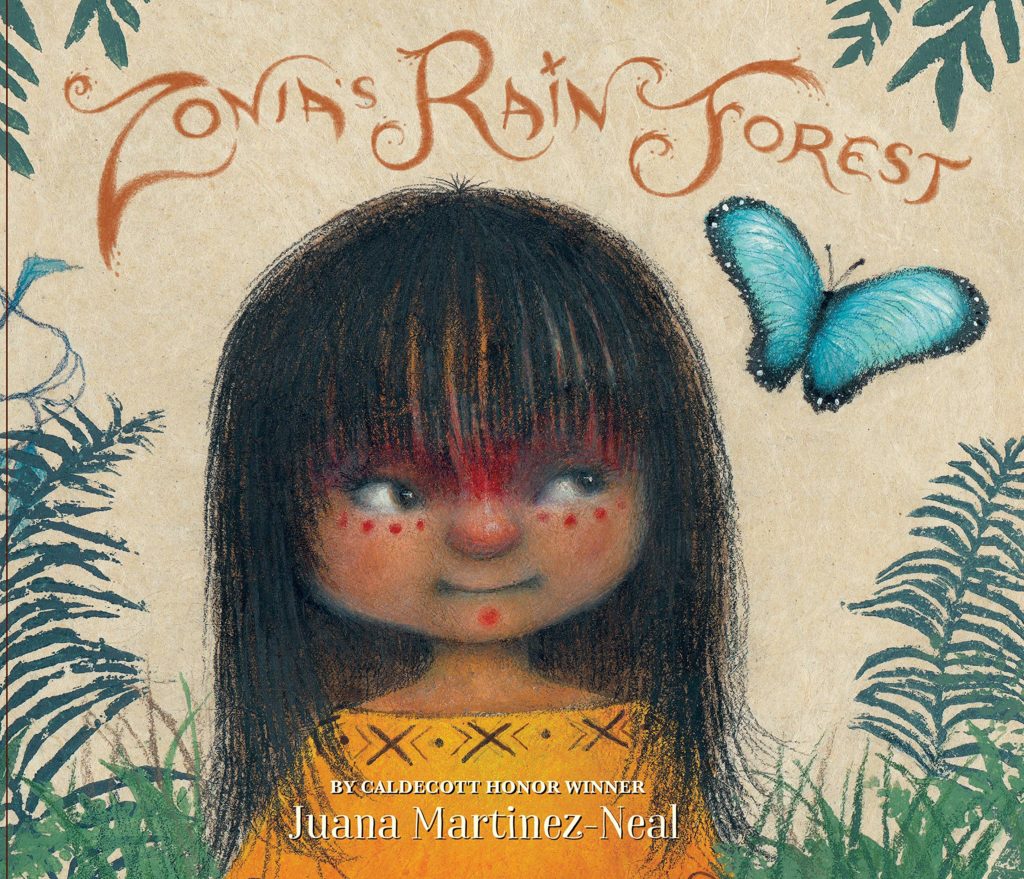
Zonia’s Rain Forest
Written and Illustrated by Juana Martinez-Neal
Ages 4-8 | 40 Pages
Publisher: Candlewick | ISBN-13: 978-1536208450
Publisher’s Synopsis: Zonia’s home is the Amazon rain forest, where it is always green and full of life. Every morning, the rain forest calls to Zonia, and every morning, she answers. She visits the sloth family, greets the giant anteater, and runs with the speedy jaguar. But one morning, the rain forest calls to her in a troubled voice. How will Zonia answer?
Acclaimed author-illustrator Juana Martinez-Neal explores the wonders of the rain forest with Zonia, an Asháninka girl, in her joyful outdoor adventures. The engaging text emphasizes Zonia’s empowering bond with her home, while the illustrations—created on paper made from banana bark—burst with luxuriant greens and delicate details. Illuminating back matter includes a translation of the story in Asháninka, information on the Asháninka community, and resources on the Amazon rain forest and its wildlife.
Buy the Book
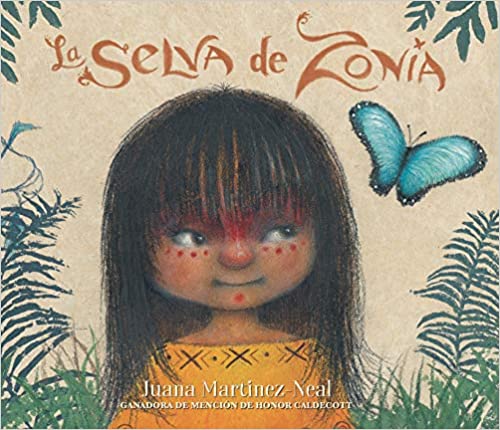
La selva de Zonia
Written and Illustrated by Juana Martinez-Neal
Ages 4-8 | 40 Pages
Publisher: Candlewick | ISBN-13: 978-1536213362
Publisher’s Synopsis: Explora las maravillas de la Amazonía con Zonia, una niña asháninka, cuyas alegres aventuras en la selva se interrumpen un día por un misterioso y desconcertante descubrimiento.
La selva es el hogar de Zonia. Es su jardín y su patio, su vecindario y su parque. Cada mañana, la selva llama a Zonia. Cada mañana, ella responde: le dice “hola” a la familia de perezosos, saluda al oso hormiguero, da una carrera con el veloz jaguar…
Una mañana, la selva llama a Zonia con una voz diferente, una voz de preocupación. Esta es la historia de esa inesperada mañana.
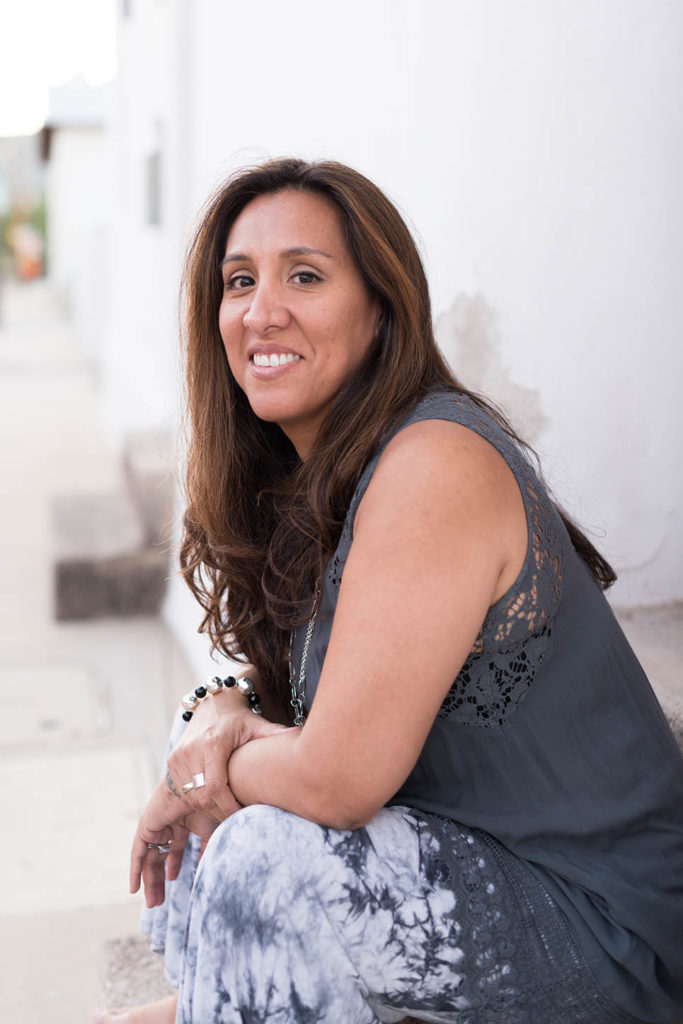
About the Author-Illustrator
Juana Martinez-Neal is the Peruvian-born daughter and granddaughter of painters. Her debut as an author-illustrator, Alma and How She Got Her Name, was awarded a Caldecott Honor and was published in Spanish as Alma y cómo obtuvo su nombre. She also illustrated La Princesa and the Pea by Susan Middleton Elya, for which she won a Pura Belpré Illustrator Award, and Fry Bread: A Native American Family Story by Kevin Noble Maillard, which won a Robert F. Sibert Medal. Juana Martinez-Neal lives in Connecticut with her family.
Visit her online at www.juanamartinezneal.com.
Read the Interview
Bianca Schulze: I am so excited to talk to you. You are one of my all-time favorite illustrators. Your artwork always brings so much joy. There is so much richness. There are always rosy cheeks. I absolutely love it. I’m excited to talk about your latest picture book. But before we do, I was hoping that you could introduce yourself to our listeners and tell them a little bit about yourself.
Juana Martinez-Neal: Well, first of all, thank you for inviting me. Happy to be here. I am an author and illustrator. If you look at the books I made, I illustrate more than I write. I was born and raised in Lima, Peru, and then moved to the U.S. when I was twenty-three. And since I moved, I found children’s books. And after having my second child, my husband kind of nudged me into the direction of children’s books. And then here I am a few years later.
Bianca Schulze: You have so many amazing books under your belt. I think what’s great about this latest book is that it’s a conversation starter about the environment and about connecting with and listening to Indigenous people. So, will you tell everybody the name of your new book and share a little bit about the story?
Juana Martinez-Neal: Sure. My latest book, my second author-illustrator picture book (after Alma and How She Got Her Name), is Zonia’s Rain Forest. It’s also coming out in English and Spanish simultaneously. Zonia is an Asháninka girl. She lives in the Peruvian Amazon. We go along with her through her day and basically, we’re just with her spending the day with her. I wanted to share the idea of home and how different people could understand home in different ways, depending on where you’re from and who you are. And I wanted to share with young readers what home could be when you live in the Amazon, in the Peruvian Amazon, specifically as an Asháninka person. So that’s it briefly, very briefly. It’s very hard for me just to put it in a few words why I have made this book.
Bianca Schulze: When did you first start working on the story? And was there a moment that inspired you to write it?
Juana Martinez-Neal: I follow ideas. I don’t know always know I’m working on a book until much later. For example, with Zonia, I was not aware that I had been chasing this idea for so long until I was completely done with the book and I was putting all my sketches and my paintings and my linocuts and some of my printmaking tools and everything. I keep a box for each book that I make. And I was putting everything back in the box because that only happens when I’m completely done. And that’s when I realized that I have been chasing this idea for many, many years. I just did not know what I was working on.
Bianca Schulze: I’m glad you brought up the different multimedia because that’s what I found in this book that I loved so much was all of the mixed media. I also read that it’s printed on a really special kind of handmade paper. I believe it was handmade banana bark paper. Is that correct?
Juana Martinez-Neal: Yes. So, I am a mixed media artist, and the reason why I’m a mixed media artist is because I like the unexpected. It keeps my attention. That’s what I would say. So, in each book, I try to change my technique slightly; I always try to throw in something new. That way I don’t know what’s going to happen, and that not knowing is what keeps me working and keeps me digging because I’m searching for something. I don’t quite know what, but I’m searching for something when I’m working on a book. So, as I was working on the sketches for Zonia, I was 100 percent clear that I was going to incorporate printmaking.
You see, in the 90s, when I was in college and then when I left college, I moved here to the U.S., and then I stopped printmaking completely. I really loved printmaking. In fact, they wanted me to graduate as a printmaker. But I want to be a painter. I really do. So, when I’m working on sketches, I’m thinking about texture and thinking about colors, and I’m thinking about technique, too. So, I knew that all the leaves, all the leaves, will be patterns—like a few shapes that I was going to repeat because I knew it would be printmaking. Most people looking at the sketches will not be able to see that, but I knew it. So that was an early-on decision.
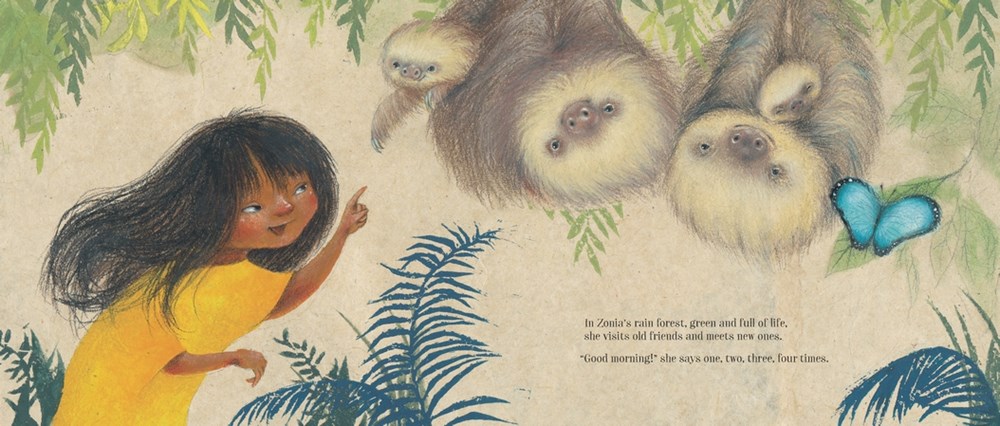
The next step was moving on to put it onto paper, I’m doing it working on the final, and I knew I needed a different type of paper. I knew I could not use a paper that I normally used. I knew something that had a heavier texture, that felt more organic. I just did not know what paper it was going to be. And when I was looking for it, I found my lifetime professor published something. She did a post about this paper that you could use to print out special diplomas or certificates. And when I saw it, I just knew this is the one. The paper was made out of banana bark. It was made by this very small group of women who learned how to do it and still do it. If I remember correctly, it started with nine women doing it and slowly went down. And now I think there’s only five women who are still making the paper. It can also be different colors—they use organic dyes if you want it red or if you want it more yellow—other natural dyes. And so as soon as I saw the paper, I knew that it was the paper, and as soon as I got the paper with me and I did the first transfer of my art and my woodcuts, I thought it was clear, it was perfect.
Bianca Schulze: I sort of feel like that all of this attention to detail, sometimes the youngest readers may not notice those techniques, but as a whole, that is what helps your artwork to just, you know, just shine. There’s so much love and attention that goes into each piece. And I just loved those little leaf cuts—the prints on the pages. I noticed those. And I just loved all the texture, and it all ties together so wonderfully.
Juana Martinez-Neal: I think that even though maybe young readers will not know exactly how you make something, how a piece is done, or how a picture book certainly was done, I know that they understand how they feel about it. And that’s how I start my work. I begin from emotion, from a feeling, and then how do I achieve that feeling in my work or my book as a whole. Right? As a whole, with words and writing. And in the case of Zonia, it was that feeling of sharing the idea of home, what is home, and how I wanted the children to read and understand. Oh, she plays hide and seek just like me. She has her best friends, just like me. She loves running around. Then to do so with building this sense of this clear understanding that Zonia is just like them. So again, I think it’s just a matter of even though they don’t understand how the artwork is made, they understand what they feel from it.
Bianca Schulze: Absolutely. I think that’s exactly what I was trying to articulate. It’s like those little details that you put into your work with love. The readers feel that you know.
So, I have a few favorite illustrations from the book, but before I share mine with you, I would love to know if there was a specific illustration or even a specific line or words that you put in the book that are your favorite.
Juana Martinez-Neal: I love the beginning. I do love the beginning that Zonia lives with those she loves in the rain forests that is green and full of life. And I that’s a beautiful set of words together. As for illustrations, my absolute favorite piece in this book is where she is lying down with the turtles, and the butterflies are flying, fluttering, and flying around her. I love the sense of quiet, but at the same time, she’s so excited. You can see it’s also thrilling. And she’s holding all of this excitement, but she wants to stay so still so she can enjoy that moment. I love that, I really do. And then the mom, the mom, when she’s at the very beginning with her mom sitting outside, I love that piece because of the feeling of family and, you know, being together.
Bianca Schulze: Yeah. I’m really glad you brought that one up because I loved that you included Zonia’s mom breastfeeding on the very first spread. We don’t see that a lot in picture books, but it is done just to perfection. It’s such a natural part of life. And I love that you included it in there.
And like you said, it shows that feeling of connection that Zonia has with her own family right from the start and then moves forward with her connection to the forest and connects the readers so that when we get to the point in the story where we see that the rainforest is in trouble, we’re equally invested as the reader, you know, so all of those little moments of building a connection with family, building a connection with the animals, building a connection with the forest itself, then we realize that that there’s trouble and that we’re all connected to that piece of trouble. We can all have a voice and a say in it. And so, you’ve created a beautiful story, but you’ve also created a conversation starter.
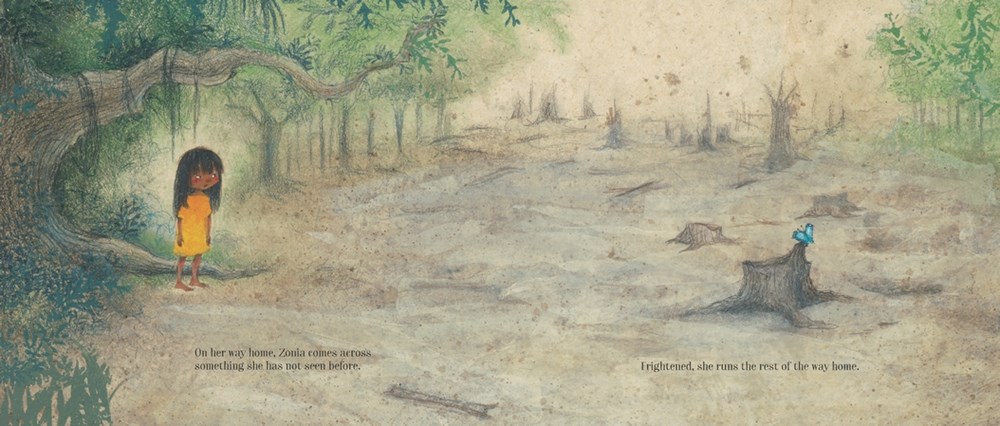
So, then we get to the very end where you’ve got this phenomenal amount of back-matter. Tell me about how you worked on the backmatter included that shares more about the Amazon and the people who live within the Amazon.
Juana Martinez-Neal: Yeah, I am not a non-fiction author, but I am an author of books for young readers, so I had an idea of what I wanted to share. But like everything, as I’m choosing to say the things that are building up, I knew I needed to include who the Asháninka people are. I thought that was key to understanding this story. Also, the idea of the back-matter was an extension and an add-on to the actual manuscript; it was by reading the back-matter, you expand on what you have seen. So now we know who they are and where they live and what’s the problem? Because I think it needs to be explained to the children.
The back-matter was a group effort, including my editor. It was not one of us. It was all of us trying to work together to get this done. I had ideas of what I wanted there, like the Asháninka people. I wanted it to be real and honest information on the situation and the concern of the people who live there. There was a lot of fine-tuning.
In the book itself, everybody is so happy-go-lucky and Zonia is so excited, and the reader is part of it. And there’s a buildup. And you’re still increasingly getting happy and relaxed and all these different emotions in the book. And then you have this moment of huge, I don’t know, confusion, I guess. That took a lot of back and forth with the scene with the threats to the Amazon in the background. How much is too much? How much should we share? Because we need an honest portrayal, right? We need the children to know the truth. Right?
Bianca Schulze: When I was reading the story for the first time, the story alone was enough for me. And so, when I got to the back-matter, it just pushed me over the edge with happiness that you had included it, because I didn’t expect it. And it was very thoughtful. And I think for families that sit down and read and enjoy your story and want to go further, it’s going to give them great steppingstones to learn more. And so, I’m glad that you and your team put all of that together. I think it’s great.
Juana Martinez-Neal: I think it’s just a starting point. I think it’s a journey from here. Families could expand into what others know, what people are doing, what Indigenous people are doing about what’s happening to them. You know, I think it’s a great starting point from here. As you said, what else can you find out, right?
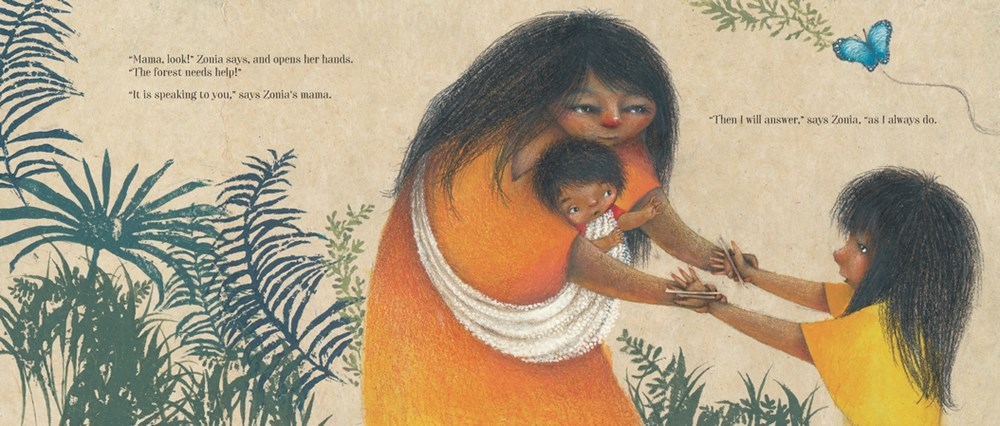
Bianca Schulze: I have always wanted to go to Peru, it’s very high on my list, and Zonia’s Rain Forest just made me think about it even more deeply about why it is that I want to go there and what would I like to see and learn about when I was there, too. I loved the story on its own. It was enough and then the back-matter just pushed me over the edge. I love this book so much.
So, I interviewed you back in 2018 to talk about Alma and How She Got Her Name, and you said that The Little Prince was your favorite book. I’m going to try and say it in Spanish: El Principito. And so, to be a writer, they say you need to be a reader first. Was reading The Little Prince a pivotal moment in which you considered yourself a reader. Do you think it turned you into a reader?
Juana Martinez-Neal: I fell in love with reading. I knew it was opening a side of me that had not been touched before. I connected. I think it was the first time I really connected to a story. Like it felt like this is really for me, you know, in a special way. It really changed everything. And not only that but because he had those illustrations mixed with the words, that made a huge difference. Now you have to think I did not grow up with picture books. So, this type of book was the first time that I saw this. I mean, we had like the ABC books, but it is just a different type of book, not like the picture books that we have in the U.S.—children here are so lucky to have them. It’s amazing that they have picture books that I did not have. I had novels. But that was something else. It was that mix of words and images. It was just perfect. I just did not know I needed that.
Bianca Schulze: I would love to know if there’s anything else you think we need to know about anything you have upcoming that you’re working on or just anything that you would love to share with the listeners?
Juana Martinez-Neal: Sure. I have a new book coming out on August 31, 2021, and that’s a book that I only illustrated. It’s written by Padma Lakshmi. It’s called Tomatoes for Neela. So that book is coming out this year.
Now about Zonia. We talked briefly about Indigenous rights and the rights of the Indigenous people over their lands. And in some way, it’s something that is also there in the book, perhaps not as the main subject, but it’s something that I was very interested in sharing.
Bianca Schulze: Yeah, I’m really glad that you did. Oh, you reminded me of something I did not ask you about. OK, so the final illustration of Zonia, she has red paint on her face. And I did learn a little bit about this paint from the backmatter. There’s a meaning to this. Are you able to share a little bit about the importance of the paint is on her face?
Juana Martinez-Neal: Sure, so the Asháninka people do body painting and face painting that is used for different occasions. They will paint their faces according to how they feel. And it will also communicate feelings like if they’re going hunting or if they’re going fishing or if they are married or all these different, not only emotions but situations. And, in a sense, expands who they are and how they feel at the moment. It can also be used to communicate determination. And that’s exactly what I chose to communicate: that spirit that Zonia is determined to protect and to be ready to stand up and protect the lands, her lands. And we’re here standing with her. But she’s leading.
Bianca Schulze: Yes. Yeah. It’s a powerful picture. And I think there’ll be so many young readers that will want to step up and follow along with her. Do you think we’ll see her again in another book?
Juana Martinez-Neal: I don’t know.
Bianca Schulze: Time will tell. Well, Juana, thank you so much for sharing your heart and your artwork with young readers and also adults like me. Your books, all of them are gorgeous. And this one is no exception.
Juana Martinez-Neal: Thank you so much.
Bianca Schulze: You’re welcome.
Juana Martinez-Neal: It’s a pleasure.
The transcription of this interview with Juana Martinez-Neal has been condensed and edited for readability.
Thank you for listening to the Growing Readers Podcast episode: Juana Martinez-Neal Discusses Zonia’s Rain Forest. For the latest episodes from The Growing Readers Podcast, Follow Now on Spotify. For similar books and articles, you can check out all of our content tagged with Indigenous People, Juana Martinez-Neal, Peru, Picture Book, and Rainforest.

